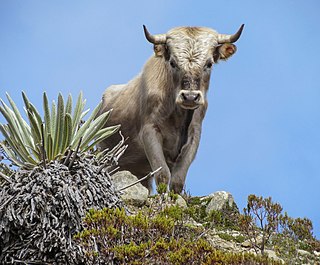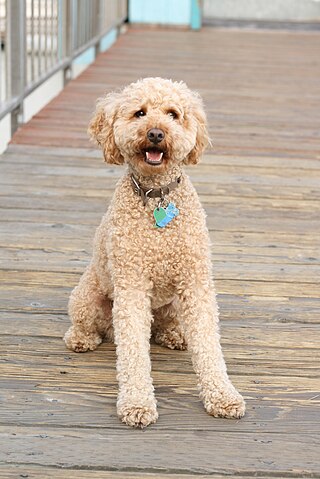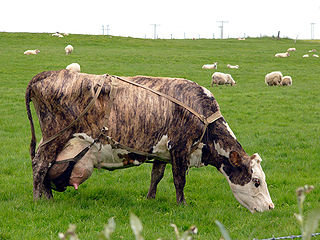Icelandic refers to anything of, from, or related to Iceland and may refer to:
Icelandic refers to anything of, from, or related to Iceland and may refer to:
Frisian most often refers to:

A feral animal or plant is one that lives in the wild but is descended from domesticated individuals. As with an introduced species, the introduction of feral animals or plants to non-native regions may disrupt ecosystems and has, in some cases, contributed to extinction of indigenous species. The removal of feral species is a major focus of island restoration.

The Icelandic horse is a breed of horse developed in Iceland. Although the horses are small, at times pony-sized, most registries for the Icelandic refer to it as a horse. Icelandic horses are long-lived and hardy. In their native country they have few diseases; Icelandic law prevents horses from being imported into the country and exported animals are not allowed to return. In addition to the gaits of walk, trot, and canter/gallop typical of other horse breeds, many Icelandic horses can also do the tölt and the flying pace. The only breed of horse in Iceland, they are also popular internationally, and sizable populations exist in Europe and North America. The breed is still used for traditional sheepherding work in its native country, as well as for leisure, showing, and racing.
Criollo or criolla may refer to:

A crossbreed is an organism with purebred parents of two different breeds, varieties, or populations. Crossbreeding, sometimes called "designer crossbreeding", is the process of breeding such an organism. While crossbreeding is used to maintain health and viability of organisms, irresponsible crossbreeding can also produce organisms of inferior quality or dilute a purebred gene pool to the point of extinction of a given breed of organism.
Breed clubs are associations or clubs with activities centered on a single, specific breed of a particular species of domesticated animal. The purpose of the association will vary with the species of animal and the goals and needs of the members of the association. Breed associations or clubs may vary in their goals, activities and nomenclature from country to country, even for the same breed. Most domesticated animals, whether they are agricultural animals such as cattle, llamas, poultry, sheep and pigs, or companion animals such as pigeons, horses, cats and dogs, have breed clubs associated with the breed.

A livestock show is an event where livestock are exhibited and judged on certain phenotypical breed traits as specified by their respective breed standard. Species of livestock that may be shown include pigs, cattle, sheep, goats, horses, llamas and alpacas. Poultry such as chickens, geese, ducks, turkeys and pigeons are also shown competitively. A livestock show may be part of an agricultural show.

The Livestock Conservancy, formerly known as the American Livestock Breeds Conservancy (ALBC) and prior to that, the American Minor Breeds Conservancy, is a nonprofit organization focused on preserving and promoting rare breeds, also known as "heritage breeds" of livestock. Founded in 1977, through the efforts of livestock breed enthusiasts concerned about the disappearance of many of the US's heritage livestock breeds, The Livestock Conservancy was the pioneer livestock preservation organization in the United States, and remains a leading organization in that field. It has initiated programs that have saved multiple breeds from extinction, and works closely with similar organizations in other countries, including Rare Breeds Canada. With 3,000 members, a staff of eleven and a 19-member board of directors, the organization has an operating budget of over a million dollars.

The Shetland Islands of Scotland have long had their own distinct animal breeds, due to the remoteness of the archipelago. Below is a list of Shetland's domesticated animals.

Icelandic cattle are a breed of cattle native to Iceland. Cattle were first brought to the island during the Settlement of Iceland a thousand years ago. Icelandic cows are an especially colorful breed with a wide variety of colours and markings. Icelandic cattle have been genetically isolated for centuries, but are most closely related to a breed in Norway called Blacksided Troender- and Nordland Cattle. No cattle are permitted to be imported into Iceland, so they have been protected by strict disease-prevention measures.
Charolais or Charollais may refer to:

The Icelandic chicken is a type of chicken from Iceland. Called íslenska hænan, Haughænsni or landnámshænan in the Icelandic language. They are a landrace fowl which are rare outside their native country. They have been present on the island since introduction by Norse settlers in the 9th century.
Sarda may refer to :

The Icelandic goat, also known as the 'settlement goat', is an ancient breed of domestic goat believed to be of Norwegian origin and dating back to the settlement of Iceland over 1100 years ago. This breed of goat was on the verge of extinction during the late 19th century, but recovered prior to World War II, only to precipitously decline again. The population has dropped below 100 animals several times, leading to genetic bottleneck. As of 2003, there were 348 goats in 48 flocks distributed throughout most parts of Iceland. At the end of 2012, the herd had increased to 849. Since this breed has been isolated for centuries, the Icelandic populations are highly inbred. The Icelandic goat is very rare outside its native land. Under its coarse, long guard hair, the Icelandic goat has a coat of high quality cashmere fiber. Icelandic goats are kept mainly as pets and their economic potential for meat, milk, cashmere and skin production remains to be explored. The Icelandic goat is currently of little economic value.

The Gesellschaft zur Erhaltung alter und gefährdeter Haustierrassen or GEH is a German national association for the conservation of historic and endangered domestic animal breeds.
Farm Animal refers to livestock.
Animal husbandry in Azerbaijan is concerned with animals that are raised for meat, milk, eggs, leather, wool, fur and fibre production for people’s consumption in Azerbaijan.